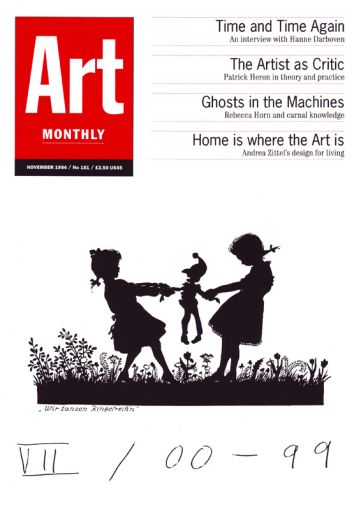Profile
Home is where the Art is
Andrea Zittel profiled by Benjamin Weil
Within our consumer society, industrial design represents the added value that is put into mass-produced objects. Industrial design is the key to the selling of an illusion. Choice is another. Being able to select a specific product among a range of brands and colours gives the consumer a feeling of control over the conduct of one’s daily life.
Having studied industrial design in addition to art, Andrea Zittel at first investigated breeding as a way of reflecting upon the structures of social conditioning. She researched the history of breeding and subsequently developed a series of Breeding Units that would enable her to carry out experiments demonstrating how those structures can create habits which in turn participate in the definition of mutations. Her more recent work has consisted in applying the conclusions of her breeding experiments onto the conditioning of humankind, eventually pointing out the absurdity – and danger – of strict scientific models.
A to Z Administrative Services started as a provider of hand-tailored models of ‘life management’ to individuals. The corporate identity the artist chose to use can be understood as a means of emphasising the function of the artist as manufacturer. This also enables Zittel to discuss both the system that generates value – originality of the design, authorship, or brand signature – as well as the type of activity that art may actually be. Industrial design is a service that is included in the chain of production rather than being a means of production itself; art, she suggests, may also be a service-oriented activity. Moreover, the parallel established between art and industrial design reveals how these two disciplines function similarly, as far as attributing value to objects is concerned. A to Z Administrative Services produces well-designed objects that are supposed to hold a specific function in its client’s life. Being produced and presented in the sphere of arts, however, they tend to be considered by the viewing – and collecting – public as purely sculptural entities.
Initially, Zittel’s corporate identity reorganised such aspects of its client’s lifestyle as their wardrobe, introducing a very practical and simplified model. Depending on the requests she received, the artist would then either select from her client’s existing set of clothes or design a ‘uniform’ which would fulfil all requisites of their routine, leaving her/him with one multipurpose outfit. The subsequent series of products released by A to Z Administrative Services somehow enacts changes that are analogous to those of mass production. From purely hand-tailored services, the company now proposes various different systems which are then fine-tuned to its client’s needs. It is from here that the Living Units originate.
The Living Units, portable, self-contained live-in structures, came after a series of Carpet Furniture which were intended to be used as the perfect means to optimise a small amount of living space. Hanging on the wall, these carpets could be laid on the floor to structure a specific activity, thus reducing both the amount of space needed as well as the amount of furniture. Ideally, the carpets would be almost all the hardware one would need in order to live. In a similar manner, Zittel has designed containers that may be used for drinking and eating in an attempt to radically simplify one’s living habits.
This utilitarian approach to minimalism was probably why the artist was invited to participate in ‘Sense and Sensibility’ at the Museum of Modern Art last summer. Zittel presented selected prototypes of products available through her company and the viewing room was transformed into some kind of a trade fair booth. Two Living Units and other products were displayed in a manner that invited the viewer to experiment with the products while a small pamphlet was available, which presented the various lines of products and services available from the artist’s company. The presentation deliberately stressed the work’s non-sculptural, utilitarian quality.
A to Z Administrative Services recently opened a show room in New York. The house actually functions as Zittel’s dwelling as well as being a laboratory: the artist has always envisioned her life as the perfect site of experimentation for her ideas. Out of solving practical domestic problems comes the work as solution, almost as a trace of some ongoing performance. In that sense, the work is only dissociated from her life by the corporate entity she has set up to ‘sign’ it and promote it. The Ottomans which are currently on exhibition in Graz are the basic constituents of her furnishing. They are rnulti-functional, serving purposes ranging from storage to bedding. Each prototype produced by A to Z Administrative Services has been thoroughly tested by the artist or friends that are invited to share the experiment.
Her forthcoming project will consist in offering visitors to a nearby group show at PS1, in which she was invited to participate, the opportunity of spending the night in one of her environments. That will enable a visitor to understand the work beyond its intrinsic sculptural quality – something the institution unfortunately cannot provide.
Benjamin Weil is a writer and curator.
Andrea Zittel responds...
I wanted to elaborate on the image you present for design. I see design as a hybrid between fine arts and applied arts ... By the 18th Century, art had developed a tactic to preserve its prestige and authority. This strategy involved presenting itself as a moral authority with access to a higher ‘truth’ than the ordinary citizen ... a tactic which design was quick to wield during its initial establishment ... remember the pseudo-scientific emphasis on hygiene and orderliness in household products?
Working as a designer from the position of an artist is not a new strategy and was the position of groups like the Bauhaus, the Russian Constructivists and De Stijl ... My departure from these movements occurs when I work with the dilemmas and the contradictions that their work unearthed. You spoke about ‘hand tailoring’ which I interpret as meaning ‘customised’, this was in some manner to reconcile the inability to establish a true universal. Also, you point out that I initially saw A to Z as a service. Later, I realised that ultimately I was only able to design to serve my own needs. Because I could not truly design for anyone else, I had to come to terms with the idea that once a product departed from my own possession, it would need to be claimed by its new owner ... What we forget is that there are at least two authors of every object: one is the designer, the other is the owner (or user). This in the end may be the solution to the dilemma presented by mass production. Where on the one hand, mass production may create greater equality by making the same goods available to everyone, on the other hand it diminishes individuality and identity. What we as consumers must do is to redefine our objects within the context of our own needs. This may mean a physical alteration or finding a more personal way of using something. At home, I use a bowl for all my drinking and eating functions. While at some point in the last few years I have used bowls that I have made, I am currently using a nice glass model I bought at a local department store: I have made it my own by using it my own personal way.
Design has a direct, if forced, consequence upon our lives. Every once in a while, good design may in some way improve our situation ... Even in the case of questionable or failed design, there is still beauty in the attempt. Modern design evokes the innocence of childhood when you would construct a house out of a blanket or fantasize about living in a dome-shaped structure or completely reconstructing the world, based on your own principle of geometry. It is the need to validate these early experiments that created the oppressive morality that we react to now.
As for Minimalism, there was a fascination for the aesthetics of the system of mass production. That might be where your reference makes the most sense as far as I relate to my work.
Andrea Zittel is an artist.
First published in Art Monthly 181: November 1994.









